Recent Storm Damage Posts
Flood Cleaning Requirements
11/29/2022 (Permalink)
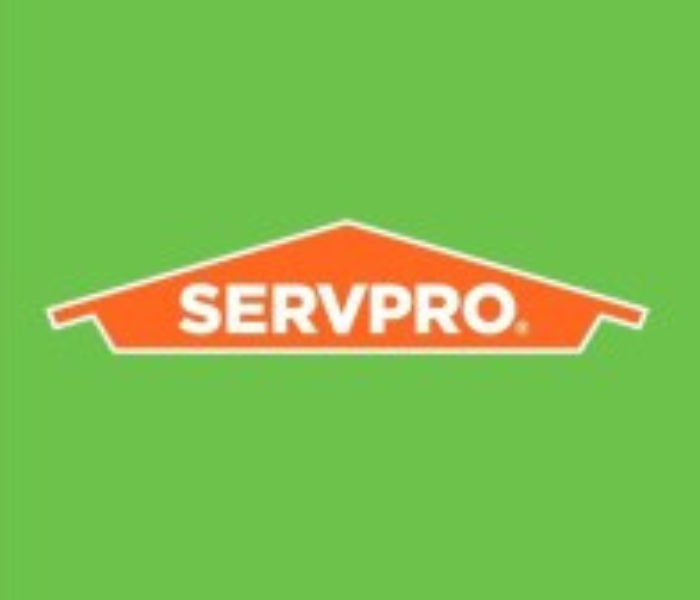 Your best bet is to contact a company that provides emergency restoration services in Orlando, FL.
Your best bet is to contact a company that provides emergency restoration services in Orlando, FL.
There are certain cleaning requirements you need to follow when sanitizing your home after a flood. You need the right flood disinfectant, and you must take steps to prevent the buildup of mold.
A flood cleaning is lengthy and complicated. It can also be dangerous if you are not properly protected. Before you start washing and drying everything, you need the proper safety gear. This includes:
- Boots
- Pants
- Long sleeves
- Elastic gloves
- Face masks
- Goggles
You also need to know how to clean the various rooms of your home. Different items need to be cared for in different ways. Below are the basic cleaning requirements and techniques for restoring your flood-damaged house.
Applying Disinfectant
To prevent the spread of bacteria throughout your home, you need to disinfect any surfaces. Start by scrubbing these surfaces with hot water and a powerful cleaner. Then apply a disinfectant. You can create your own by combining a gallon of water with a quarter-cup of chlorine bleach.
Cleaning the Kitchen
Metal items such as pots, utensils, and pans should not be cleaned with bleach. Instead, disinfect them by boiling them in water for 10 minutes. A bleach solution can be used on china, glass, porcelain, and enamel items, however. Be sure to disinfect your counters and cupboards before putting dishes away.
Saving Your Valuables
Some items, such as mattresses, stuffed animals, and toys, may have to be thrown away after a flood. However, you may be able to freeze books and photographs after wiping off excess mud. You can then thaw them and take them to an expert for cleaning.
Most floods cause complex damage that one person cannot handle by himself. If you do start the process alone, be sure to follow the above cleaning requirements. However, your best bet is to contact a company that provides emergency restoration services in Orlando, FL. Professionals can safely clean up your home and dry your belongings.
Precautions When Living in a Flood Zone
11/29/2022 (Permalink)
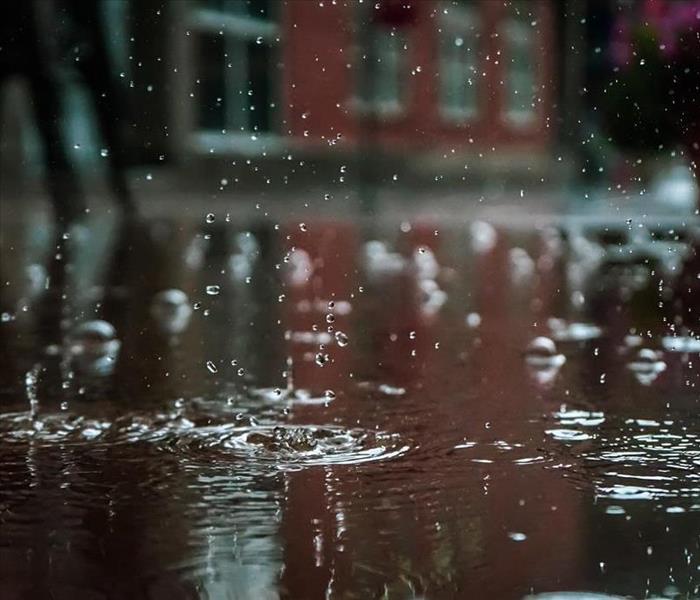 For the damage that you can't avoid, though, you need trusted cleanup professionals and an insurance policy that covers it.
For the damage that you can't avoid, though, you need trusted cleanup professionals and an insurance policy that covers it.
Living next to the beach or in a low-lying area may be a lifelong dream, but it can come with added risks. One such risk is having a home in a flood zone. You don't have to give up what may otherwise be a great location, though. There are several precautions you can take to minimize your risk of flood damage.
Protect Your Home
An active storm season in Florida can test the boundaries of your home like nothing else. While you may not be able to fully keep your home from flooding, there are several ways you can prepare for an upcoming rainstorm:
- Put sandbags out as a barrier against rising water.
- Install a sump pump in your basement on or the lower level of your home.
- Place outlets or sensitive equipment higher on the wall or on a shelf.
It's also a good idea to have an evacuation plan, just in case the water rises so high you need to leave your home. Even if your home floods, you can have measures already in place to deal with the fallout.
Purchase Insurance
If your home is in a flood zone, you need to have flood insurance. This coverage is not typically part of your homeowners' policy, so you'll need to purchase it separately. If your insurance company doesn't offer flood insurance, you can get a referral for a company that does from the National Flood Insurance Program.
Plan for Remediation
Flooding can produce serious damage to your home. Have the contact information for local flood restoration specialists handy. They can assess the damage to your home and give you an estimate of how much the repairs are going to cost.
When your home is in a flood zone, you have to take some factors into consideration that other homeowners do not. You may be able to minimize some damage. For the damage that you can't avoid, though, you need trusted cleanup professionals and an insurance policy that covers it.
Prevent Mold Growth After a Flood
6/16/2022 (Permalink)
Mold growth after flooding in your Orlando, FL, home can be a major headache. However, if you act quickly, you can protect your residence from mold damage.
Preventing Mold Infestation
Because mold can begin to grow as soon as 24 hours after a flood, it is important to address the problem right away. Here are the basic steps for drying out a flooded area:
- Remove standing water. The amount of water present will determine the best method for this job. Pumps and wet/dry vacs are commonly used.
- Make a flood cut. Because water tends to wick upward behind walls, it is important to remove all drywall and insulation up to at least 12 inches above the waterline.
- Dry or remove any other wet items. Make sure anything you decide to keep is completely dry.
Run fans and dehumidifiers in the flooded area. This will help to remove any remaining moisture and retard the growth of mold. - Disinfect all of the surfaces that were exposed to water. Flood water is considered black water and contains harmful bacteria. Trisodium phosphate, bleach, and commercial mold cleaners are all effective methods for disinfecting, but be sure to follow the instructions carefully.
Remediating Mold Growth
Unfortunately, it is not always feasible to fully dry out a flooded area before mold begins to grow. However, it is still important to work quickly. Containing and cleaning the mold as soon as possible may prevent it from spreading and doing more damage to your home’s structure. Turn off the HVAC unit so that mold spores do not spread throughout your home. You may also want to use an air scrubber to capture any mold spores floating in the air. Bleach and specially formulated mold cleaners can generally kill much of the mold present on your home’s surfaces. However, areas with more extensive damage may need to be replaced.
Although the aftermath of a flood can be overwhelming, help is available. Whether you are drying out a space to prevent mold growth or dealing with an existing mold issue, a professional restoration team can make sure the job is done thoroughly, safely, and quickly.
Pet Storm Preparedness
6/10/2022 (Permalink)
Did you know that almost all dog and cat owners don't have disaster plans for their pets? SERVPRO of SW Orlando urges you to make sure this isn’t you.
You made a disaster kit for yourself and your family, so make one for your pet. This includes medical records and medication, food and water with can openers, leashes, and carriers.
Tips:
- Keep pets inside during a storm. Animals can become confused and run away from home during a disaster.
- Arrange a safe haven for you and your pets during an evacuation. Do not leave pets behind.
- Store an emergency kit—with items such as pet food, bottled water, medical records, a blanket, a flashlight, and leashes—as close to an exit as possible.
- Make sure all pets wear collars and tags.
- Have your pet microchipped in case of a lost collar.
- Place a rescue alert sticker to your front home to let rescuers know that there are pets inside.
- Choose a caregiver to take care of your pet in the event you are unable to.
SERVPRO of SW Orlando 407-704-0327
Severe Thunderstorm Watch vs. Warning
5/14/2022 (Permalink)
It is always important to keep up with what’s happening with the weather in your area. One of the biggest questions asked is, what is the difference between a severe thunderstorm watch and a severe thunderstorm warning? A severe thunderstorm watch is issued by the SPC (Storm Prediction Center) and means that there is potential for the development of thunderstorms that can produce large hail or damaging winds. When a severe thunderstorm is in progress or has developed and is shown on your local news radar it is called a severe thunderstorm warning.
SERVPRO of Southwest Orlando is a Florida State licensed Certified Building Contractor, Mold Remediator, and Mold Assessor. We are IICRC (Institute of Inspection Cleaning and Restoration Certification) certified in Fire/Water/Mold clean-up & restoration. Call us today, we are always here to help.
What To Do Right After a Storm Damages Your Home
8/3/2021 (Permalink)
You hear the wind blowing and the rain pounding on your window panes, and you hope your home will remain untouched by the storm. Unfortunately, this is not the case. A tree falls on your roof, and water pours into your home, soaking your carpets and covering your hardwood floors. Here's how to stem the tide of storm damage in the event's immediate aftermath.
1. Document Damage Before Attempting Immediate Repairs
If you are planning to submit a claim to your insurance company for the damages, you will want to record them prior to attempting any immediate repairs. Make a list of damaged items, and take photos or videos of each.
2. Make Immediate Repairs Only To Prevent Further Damage to Your Home
Take the following steps when attempting immediate repairs or cleanup:
- Cover leaking roofs with a tarp to prevent more rainfall from entering the home.
- Pull up a wet carpet to prevent mold and move it to a dry location.
- Throw away all perishable food that has spoiled.
Make sure all articles being removed from the home were documented on the inventory list of damaged items.
3. Exercise Caution If You're Staying in a Damaged Home
To restore lost electricity in your home, use generators outside, away from windows and doors. Make sure your sewer system is working before flushing toilets, using water stored previously for this function if necessary. Open windows and run fans inside your home to circulate air and aid the drying process.
You may also choose to contact a company that can perform emergency restoration services in your home. If so, keep receipts for services provided, as well as for any purchases made for immediate repairs, such as a tarp for the leaking roof.
Hopefully, your home will never be subjected to storm damage. If it is, however, these storm tips can get you started on the road to recovery and get your life back to normal as quickly as possible.
Prevent Mold Growth After A Flood
6/16/2021 (Permalink)
Mold growth after flooding in your Orlando, FL, home can be a major headache. However, if you act quickly, you can protect your residence from mold damage.
Preventing Mold Infestation
Because mold can begin to grow as soon as 24 hours after a flood, it is important to address the problem right away. Here are the basic steps for drying out a flooded area:
- Remove standing water. The amount of water present will determine the best method for this job. Pumps and wet/dry vacs are commonly used.
- Make a flood cut. Because water tends to wick upward behind walls, it is important to remove all drywall and insulation up to at least 12 inches above the waterline.
- Dry or remove any other wet items. Make sure anything you decide to keep is completely dry.
Run fans and dehumidifiers in the flooded area. This will help to remove any remaining moisture and retard the growth of mold. - Disinfect all of the surfaces that were exposed to water. Flood water is considered black water and contains harmful bacteria. Trisodium phosphate, bleach, and commercial mold cleaners are all effective methods for disinfecting, but be sure to follow the instructions carefully.
Remediating Mold Growth
Unfortunately, it is not always feasible to fully dry out a flooded area before mold begins to grow. However, it is still important to work quickly. Containing and cleaning the mold as soon as possible may prevent it from spreading and doing more damage to your home’s structure. Turn off the HVAC unit so that mold spores do not spread throughout your home. You may also want to use an air scrubber to capture any mold spores floating in the air. Bleach and specially formulated mold cleaners can generally kill much of the mold present on your home’s surfaces. However, areas with more extensive damage may need to be replaced.
Although the aftermath of a flood can be overwhelming, help is available. Whether you are drying out a space to prevent mold growth or dealing with an existing mold issue, a professional restoration team can make sure the job is done thoroughly, safely, and quickly.
Pet Storm Preparedness
6/10/2021 (Permalink)
Did you know that almost all dog and cat owners don't have disaster plans for their pets? SERVPRO of SW Orlando urges you to make sure this isn’t you.
You made a disaster kit for yourself and family, so make one for your pet. This includes medical records and medication, food and water with can openers, leashes, and carriers.
Tips:
- Keep pets inside during a storm. Animals can become confused and run away from home during a disaster.
- Arrange a safe haven for you and your pets during evacuation. Do not leave pets behind.
- Store an emergency kit—with items such as pet food, bottled water, medical records, a blanket, a flashlight and leashes—as close to an exit as possible.
- Make sure all pets wear collars and tags.
- Have your pet microchipped in case of a lost collar.
- Place a rescue alert sticker to your front home to let rescuers know that there are pets inside.
- Choose a caregiver to take care of your pet in the event you are unable to.
SERVPRO of SW Orlando 407-704-0327
Severe Thunderstorm Watch vs. Warning
5/12/2021 (Permalink)
It is always important to keep up with what’s happening with the weather in your area. One of the biggest questions asked is, what is the difference between a severe thunderstorm watch and a severe thunderstorm warning? A severe thunderstorm watch is issued by the SPC (Storm Prediction Center) and means that there is potential for the development of thunderstorms that can produce large hail or damaging winds. When a severe thunderstorm is in progress or has developed and is shown on your local news radar it is called a severe thunderstorm warning.
SERVPRO of Southwest Orlando is a Florida State licensed Certified Building Contractor, Mold Remediator, and Mold Assessor. We are IICRC (Institute of Inspection Cleaning and Restoration Certification) certified in Fire/Water/Mold clean-up & restoration. Call us today, we are always here to help.
Cleaning Requirements After a Home Flood
11/13/2020 (Permalink)
There are certain cleaning requirements you need to follow when sanitizing your home after a flood. You need the right flood disinfectant, and you must take steps to prevent the buildup of mold.
A flood clean is lengthy and complicated. It can also be dangerous if you are not properly protected. Before you start washing and drying everything, you need the proper safety gear. This includes:
- Boots
- Pants
- Long sleeves
- Elastic gloves
- Face masks
- Goggles
You also need to know how to clean the various rooms of your home. Different items need to be cared for in different ways. Below are the basic cleaning requirements and techniques for restoring your flood-damaged house.
Applying Disinfectant
To prevent the spread of bacteria throughout your home, you need to disinfect any surfaces. Start by scrubbing these surfaces with hot water and a powerful cleaner. Then apply a disinfectant. You can create your own by combining a gallon of water with a quarter-cup of chlorine bleach.
Cleaning the Kitchen
Metal items such as pots, utensils and pans should not be cleaned with bleach. Instead, disinfect them by boiling them in water for 10 minutes. A bleach solution can be used on china, glass, porcelain and enamel items, however. Be sure to disinfect your counters and cupboards before putting dishes away.
Saving Your Valuables
Some items, such as mattresses, stuffed animals and toys, may have to be thrown away after a flood. However, you may be able to freeze books and photographs after wiping off excess mud. You can then thaw them and take them to an expert for cleaning.
Most floods cause complex damage that one person cannot handle by himself. If you do start the process alone, be sure to follow the above cleaning requirements. However, your best bet is to contact a company that provides emergency restoration services in Orlando, FL. Professionals can safely clean up your home and dry your belongings.
Precautions To Take When Your Home Is in a Flood Zone
11/13/2020 (Permalink)
Living next to the beach or in a low-lying area may be a lifelong dream, but it can come with added risks. One such risk is having a home in a flood zone. You don't have to give up what may otherwise be a great location, though. There are several precautions you can take to minimize your risk of flood damage.
Protect Your Home
An active storm season in Florida can test the boundaries of your home like nothing else. While you may not be able to fully keep your home from flooding, there are several ways you can prepare for an upcoming rainstorm:
- Put sandbags out as a barrier against rising water.
- Install a sump pump in your basement on or the lower level of your home.
- Place outlets or sensitive equipment higher on the wall or on a shelf.
It's also a good idea to have an evacuation plan, just in case the water rises so high you need to leave your home. Even if your home floods, you can have measures already in place to deal with the fallout.
Purchase Insurance
If your home is in a flood zone, you need to have flood insurance. This coverage is not typically part of your homeowners' policy, so you'll need to purchase it separately. If your insurance company doesn't offer flood insurance, you can get a referral for a company that does from the National Flood Insurance Program.
Plan for Remediation
Flooding can produce serious damage to your home. Have the contact information for local flood restoration specialists handy. They can assess the damage to your home and give you an estimate of how much the repairs are going to cost.
When your home is in a flood zone, you have to take some factors into consideration that other homeowners do not. You may be able to minimize some damage. For the damage that you can't avoid, though, you need trusted cleanup professionals and an insurance policy that covers it.
What To Do Right After a Storm Damages Your Home
7/30/2020 (Permalink)
You hear the wind blowing and the rain pounding on your window panes, and you hope your home will remain untouched by the storm. Unfortunately, this is not the case. A tree falls on your roof, and water pours into your home, soaking your carpets and covering your hardwood floors. Here's how to stem the tide of storm damage in the event's immediate aftermath.
1. Document Damage Before Attempting Immediate Repairs
If you are planning to submit a claim to your insurance company for the damages, you will want to record them prior to attempting any immediate repairs. Make a list of damaged items, and take photos or video of each.
2. Make Immediate Repairs Only To Prevent Further Damage to Your Home
Take the following steps when attempting immediate repairs or cleanup:
- Cover leaking roofs with a tarp to prevent more rainfall from entering the home.
- Pull up wet carpet to prevent mold and move it to a dry location.
- Throw away all perishable food that has spoiled.
Make sure all articles being removed from the home were documented on the inventory list of damaged items.
3. Exercise Caution If You're Staying in a Damaged Home
To restore lost electricity in your home, use generators outside, away from windows and doors. Make sure your sewer system is working before flushing toilets, using water stored previously for this function if necessary. Open windows and run fans inside your home to circulate air and aid the drying process.
You may also choose to contact a company that can perform emergency restoration services in your home. If so, keep receipts for services provided, as well as for any purchases made for immediate repairs, such as a tarp for the leaking roof.
Hopefully, your home will never be subjected to storm damage. If it is, however, these storm tips can get you started on the road to recovery and get your life back to normal as quickly as possible.
SERVPRO Storm Response
6/16/2020 (Permalink)
When it comes to fire & water damage, or specialty cleanup needs, it's SERVPRO brand that comes to mind. Our TEAMS work endlessly to make sure our customers are happy, and have one objective in the aftermath of disaster, to make their loss "Like it never even happened."
No matter the job size, our SERVPRO teams are ready to handle any size loss. With 1,700+ franchises nationwide, we have access to numerous highly trained personnel and thousands of pieces of equipment. Our SERVPRO Disaster Recovery teams are strategically placed throughout the country to respond when needed. Our Teams have a proven track record for success, assisting with cleanup of floods, tornadoes, wildfires, and damage caused from frigid temperatures.
Whether it’s a major storm event, or faulty appliance, we will be there with one call.
When Storms or Floods hit, SERVPRO is ready!
6/2/2020 (Permalink)
When Storms or Floods hit, SERVPRO is ready!
SERVPRO specializes in storm and flood damage restoration. Our crews are highly trained and we use specialized equipment to restore your property to its pre-storm condition.
Faster Response
Since we are locally owned and operated, we are able to respond quicker with the right resources, which is extremely important. A fast response lessens the damage, limits further damage, and reduces the restoration cost.
Resources to Handle Floods and Storms
When storms hit, we can scale our resources to handle a large storm or flooding disaster. We can access equipment and personnel from a network of 1,800 franchises across the country and elite Disaster Recovery Teams that are strategically located throughout the United States.
Have Storm or Flood Damage? Call Us Today 1(407)704-0327
Cleaning Under Home After A Flood
5/12/2020 (Permalink)
Under Home Cleaning - After Flooding
Many homeowners are eager to begin cleaning their homes after a flood although, few people realize that the area underneath houses often need to be cleaned after a flood. Here are a few helpful things to know about cleaning crawlspaces after a flood.
Though damage in a crawlspace may not be immediately apparent, identifying damage in a timely manner is often important. The following are common indicators that a crawlspace has been affected by a storm:
- An unpleasant, musty odor in areas above and around the crawlspace due to mold growth
- Damaged subfloors or warped vinyl floors
- High levels of humidity in rooms above the crawlspace
A home flood can cause major damage to both the interior and exterior of a home, and though crawlspaces are often overlooked, they are still prone to damage. When water quickly accumulates under a house it is not removed or drained, the structure of the house can be affected. Crawlspace damage can also occur if there are high levels of humidity in the area. This can cause building materials to absorb the moisture and weaken.
Thankfully there are steps that storm damage restoration company professionals take to clean your home’s crawlspace. First, water is removed from the crawlspace. If mold and high levels of humidity remain present after all the water is extracted, professionals may create negative air pressure in the area to dry it up. Once the area is dry, professionals may restore or replace any materials that have been damaged.
Though floods can wreak havoc on your home, it is important to understand the cleaning steps to take after, to prevent any future issues. Knowing the signs of a damaged crawlspace, common causes of damage and how the underside of your house is cleaned can make the clean up process much simpler.
Cleaning Requirements After a Home Flood
11/13/2019 (Permalink)
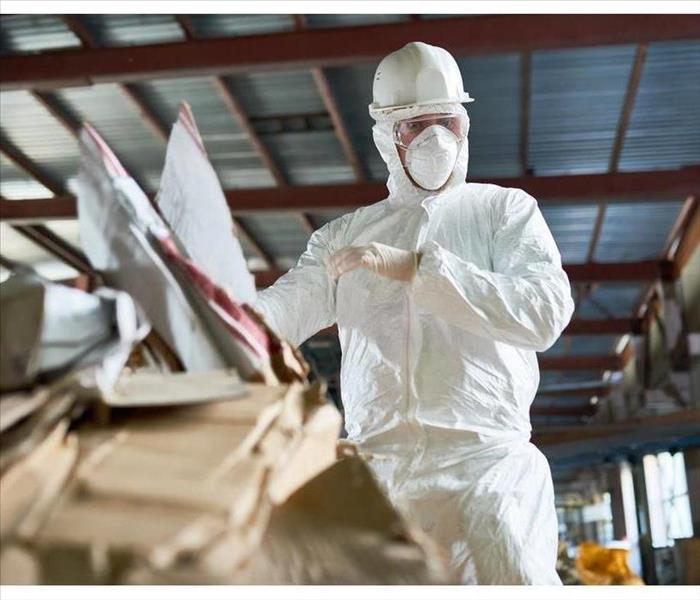 Before you start cleaning a flood you need to use proper safety gear
Before you start cleaning a flood you need to use proper safety gear
Cleaning Requirements After a Home Flood
There are certain cleaning requirements you need to follow when sanitizing your home after a flood. You need the right flood disinfectant, and you must take steps to prevent the buildup of mold.
A flood clean is lengthy and complicated. It can also be dangerous if you are not properly protected. Before you start washing and drying everything, you need the proper safety gear. This includes:
- Boots
- Pants
- Long sleeves
- Elastic gloves
- Face masks
- Goggles
You also need to know how to clean the various rooms of your home. Different items need to be cared for in different ways. Below are the basic cleaning requirements and techniques for restoring your flood-damaged house.
Applying Disinfectant
To prevent the spread of bacteria throughout your home, you need to disinfect any surfaces. Start by scrubbing these surfaces with hot water and a powerful cleaner. Then apply a disinfectant. You can create your own by combining a gallon of water with a quarter-cup of chlorine bleach.
Cleaning the Kitchen
Metal items such as pots, utensils and pans should not be cleaned with bleach. Instead, disinfect them by boiling them in water for 10 minutes. A bleach solution can be used on china, glass, porcelain and enamel items, however. Be sure to disinfect your counters and cupboards before putting dishes away.
Saving Your Valuables
Some items, such as mattresses, stuffed animals and toys, may have to be thrown away after a flood. However, you may be able to freeze books and photographs after wiping off excess mud. You can then thaw them and take them to an expert for cleaning.
Most floods cause complex damage that one person cannot handle by himself. If you do start the process alone, be sure to follow the above cleaning requirements. However, your best bet is to contact a company that provides emergency restoration services in Orlando, FL. Professionals can safely clean up your home and dry your belongings.
What Not To Do After a Flood
10/24/2019 (Permalink)
Water damage is typically extensive in a flooded home, leaving many items destroyed. Flood water contaminates everything it touches, making surviving the aftermath almost as dangerous as the storm. Staying safe after a flood doesn’t have to be challenging, but there are a few things that you should not do.
1. Don’t Go Out in Regular Clothing
As flooding water is contaminated and it is likely hiding additional dangers, like downed power lines and submerged electrical outlets, it is essential to wear protective clothing such as rubber boots and rubber gloves. Additionally, you should avoid wearing anything that will allow your skin to come into direct contact with the water.
2. Don’t Touch the Water
You should avoid direct contact with any standing flood water because most of this water will be considered category three black water. Black water is a mix of sewage and other contaminants that are highly toxic to humans and animals, and this water does not need to be ingested to inflict harm.
3. Don’t Let Your Cell Phone Die
Try to maintain a full battery on your cell phone, if at all possible. As many areas will still be covered in water, a cell phone may be your only way of contacting friends and family or emergency services.
4. Don’t Buy New Furniture
While it is tempting to purchase replacement furniture for your home, buying new furniture so soon after flooding can be a bad decision. The cleanup process takes a lot longer than most homeowners expect, and you don’t want to bring new furniture into a contaminated space because you risk further contamination.
5. Don’t Go it Alone
Call your local SERVPRO, SERVPRO of Southwest Orlando, to help you through this tough time. 407-704-0327
Preparing for a Storm as a Property Manager
10/24/2019 (Permalink)
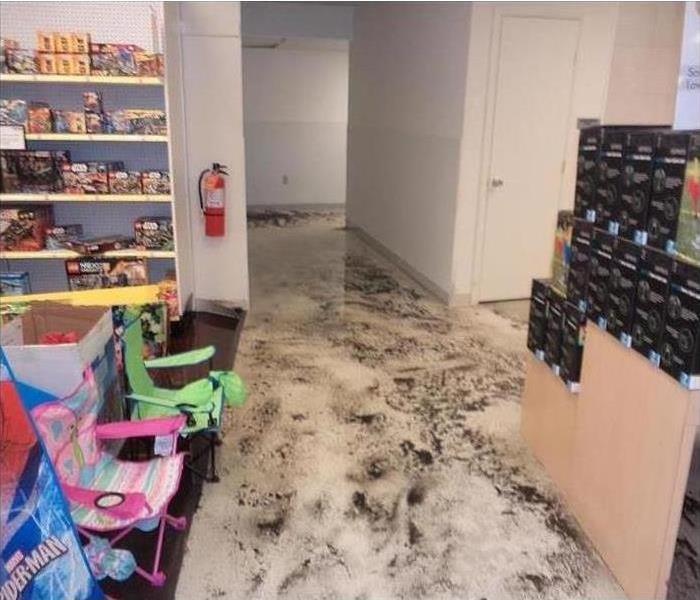 Storm damage in an Orlando, FL warehouse
Storm damage in an Orlando, FL warehouse
Here Are Some Tips to Prepare During all Stages of a Storm
One major responsibility for property owners along coastal areas is storm preparedness. You have a duty to ensure that both your property and tenants are prepared for a natural disaster. Here are some helpful tips to prepare during all stages of a storm.
Before the Storm
Proper preparation before the storm hits is critical to help minimize storm damage. You should work with key individuals who can help create a detailed property management action plan. These individuals could be managers and emergency personnel. Your pre-storm hurricane action plan should include the following:
- Evacuation routes
- Emergency response numbers
- Shelter information
- Disaster-relief information
- Contracts and policies
- Emergency contact list
- Designated liaison during a storm
Good property management skills demand that you have both physical and intellectual assets secure. Make sure that your files are backed up on a hard drive or in the cloud. Proper storm preparedness should also include annual training for staff and tenants to help minimize flood damage. Additionally, it’s a good idea to take pictures of your property and equipment before a storm. This documentation will be helpful during insurance claims.
During the Storm
Once it’s determined that a hurricane is about to happen in Orlando, FL, and winds have reached speeds of 45 mph, it’s necessary that all staff and tenants evacuate. Property management personnel should shut off all possible equipment according to emergency evacuation guidelines. Before all staff and tenants leave, be sure to give clear instructions that no one should return until hearing from the designated liaison.
After the Storm
Once it’s safe to return to your property, a thorough investigation should be conducted. Provide both written and photographed documentation of your property and possessions. Inform all employees and tenants that it’s safe to return. You should also contact a commercial storm specialist to assist in your flood cleanup efforts.
Proper storm preparedness includes planning for all storm phases. Storm cleanup will go much easier if all individuals know what to do before, during and after the hurricane.
How To Prevent Mold Growth After a Flood
9/11/2019 (Permalink)
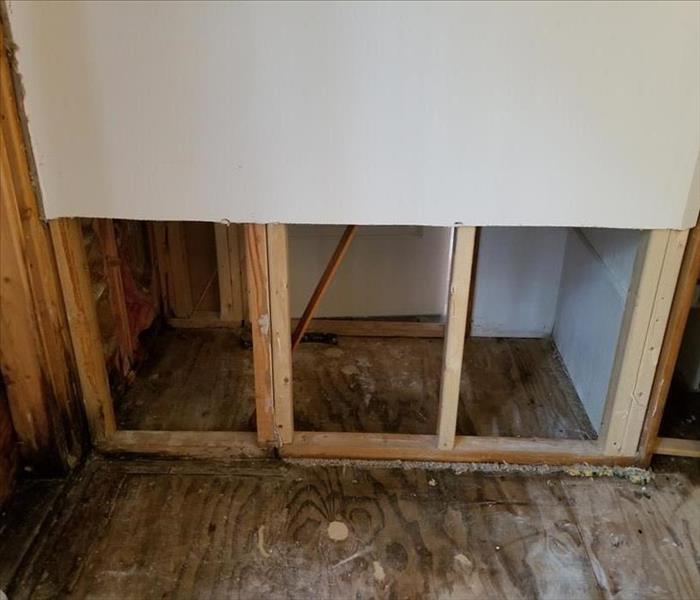 Make a flood cut
Make a flood cut
Mold growth after flooding in your Orlando, FL, home can be a major headache. However, if you act quickly, you can protect your residence from mold damage.
Preventing Mold Infestation
Because mold can begin to grow as soon as 24 hours after a flood, it is important to address the problem right away. Here are the basic steps for drying out a flooded area:
- Remove standing water. The amount of water present will determine the best method for this job. Pumps and wet/dry vacs are commonly used.
- Make a flood cut. Because water tends to wick upward behind walls, it is important to remove all drywall and insulation up to at least 12 inches above the waterline.
- Dry or remove any other wet items. Make sure anything you decide to keep is completely dry.
Run fans and dehumidifiers in the flooded area. This will help to remove any remaining moisture and retard the growth of mold.
- Disinfect all of the surfaces that were exposed to water. Flood water is considered black water and contains harmful bacteria. Trisodium phosphate, bleach and commercial mold cleaners are all effective methods for disinfecting, but be sure to follow the instructions carefully.
Remediating Mold Growth
Unfortunately, it is not always feasible to fully dry out a flooded area before mold begins to grow. However, it is still important to work quickly. Containing and cleaning the mold as soon as possible may prevent it from spreading and doing more damage to your home’s structure. Turn off the HVAC unit so that mold spores do not spread throughout your home. You may also want to use an air scrubber to capture any mold spores floating in the air. Bleach and specially formulated mold cleaners can generally kill much of the mold present on your home’s surfaces. However, areas with more extensive damage may need to be replaced.
Although the aftermath of a flood can be overwhelming, help is available. Whether you are drying out a space to prevent mold growth or dealing with an existing mold issue, a professional restoration team can make sure the job is done thoroughly, safely and quickly.
What To Do After a Flood
8/14/2019 (Permalink)
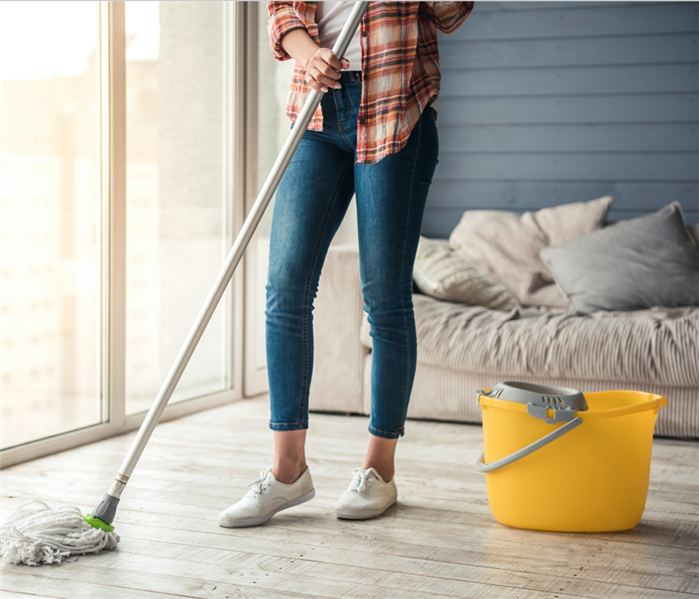 Mopping the area
Mopping the area
Flooding can take a huge toll on business owners as they try to deal with cleaning and restoring their building after a flood occurs. While the first inclination might be to start cleaning the area and salvaging whatever can be saved, there are several hazards to be aware when entering an area affected by flood water. Before doing anything after a flood occurs, quickly take the following steps.Determine Safety
Your first concern when addressing a flood in your business is to determine whether it is safe or not to enter the area. It is very important to consider if the water might be contaminated. If dealing with a sewage backup or water from a nearby river, the water is considered Category 3 water. Also called black water, this type of flood water contains contaminants that can potentially cause harm to people or pets nearby.
Call for Help
If a lot of storm damage or water damage has occurred, it will be nearly impossible to effectively handle the situation on your own. Quickly get in contact with a water damage cleanup company to help mitigate the damage and restore your building to its original condition. If dealing with Category 3 water or another hazardous situation, do not enter the flooded area until the specialists say it is safe to do so.
Dry the Area
If you have determined there are no safety concerns, you can try to dry some of the water in the area while waiting for help to arrive. Depending on where the flooding is located, you can try mopping the area, moving belongings and furniture, or hanging damp fabrics,
Knowing how to act in the case of a flood can help keep everyone in your building in Orlando, FL, safe and minimize the amount of damage the flood water causes. While you want to act quickly, make sure to analyze the situation first and get the help you need.
Canceled Flights Don't Have To Ruin Your Plans
7/8/2019 (Permalink)
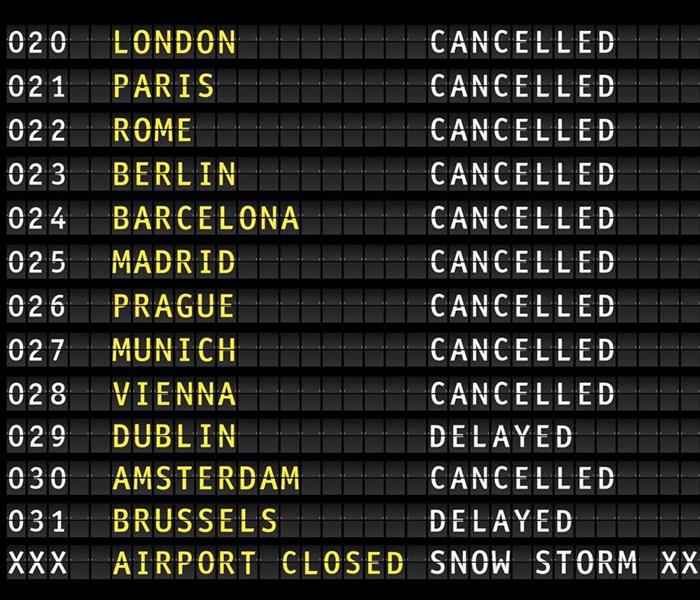 Canceled flight
Canceled flight
Tips to Avoid a Canceled Flight
Flying during the winter or hurricane season can be nerve wracking. You may never know whether or not your plane will actually be taking off when it's supposed to. To avoid a canceled flight in Orlando, FL, or handle it with ease, there are some simple tips you can follow.
Track the Weather
Especially if you are traveling during a season with rough storm patterns, you should watch the weather news carefully leading up to your trip. Sometimes airlines will compensate you or allow for a different booking because of bad weather. Don't forget to check in on any storm damage happening to your property. Some storm tips to keep in mind:
Check the forecast before booking in the first place.
Avoid connecting flights that include cities experiencing weather or are prone to it.
If you happen to see something pop up on the radar with enough notice, try to immediately reschedule your flight.
Wait It Out
When you find out about a canceled flight, whether you're traveling to your destination or trying to leave, you might have to stay put. Sometimes hotel stays are unavoidable. Try to make the best of it and think of it as a mini vacation- maybe even treat yourself to some room service. Sometimes airlines will cover the hotel stay for you, so be sure to give them a call or check at the airport.
Call the Airline
If you're already in the airport when your flight is cancelled, don't join the long line at the service desk. It can be way quicker to call the airline directly to re-book your flight. Sometimes flight apps can achieve the same thing. Then, while everyone else is still waiting, you can get on with the rest of your arrangements or head on home until your next flight.
A canceled flight can be very frustrating. If you keep your wits about you and plan for the worst, nothing the sky sends your way can throw you for a loop. Don't let a single obstacle prevent you from having a good trip!
Prevent Mold Growth After a Flood
5/8/2019 (Permalink)
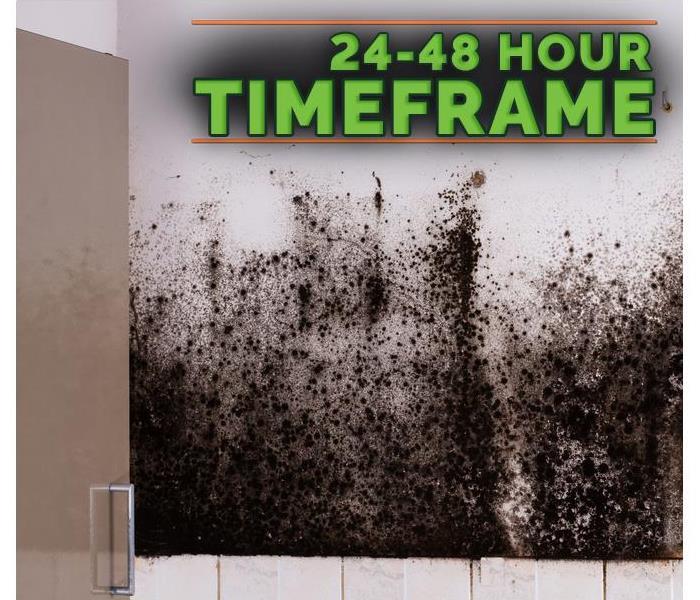 Mold will quickly grow in the first 24-48 hours
Mold will quickly grow in the first 24-48 hours
Prevent Mold Growth After a Flood
There is a lot that needs attention after a flood. One of the most serious issues is mold growth, which can cause property damage if left untreated. If your business in Orlando, FL, is affected by mold after a flood, take these steps to prevent any major damage to your building.
Remove Any Moisture
After a flood, it is common for water to accumulate in lower levels of a building or in a nearby yard. This standing water can lead to problems with the following:
- Mold
- Bacteria
- Insects
- Vermin
Mold and bacteria are particularly frequent in the presence of standing water, as they both favor moist areas to grow and reproduce. Professional services are available for water removal, making cleanup quick and easy. Be sure to get this done as soon as possible, since mold can begin growing within hours.
Control the Mold
If left untreated and allowed to grow, mold can cause many different problems for a building. Some materials such as drywall and insulation are very porous and will be unsalvageable once mold has grown. Any surface made of wood will eventually be destroyed, as the mold will eat away at it and absorb the nutrients within. Though concrete will not be destroyed by mold, it can act as a moisture source for the spores to grow and spread. Any of these can lead to added expenses or repairs if not addressed.
If you do find that mold has grown as a result of flooding, call a mold remediation specialist to handle the mold growth. Mold spores can enter your business via doors or windows, a ventilation or heating system or on the clothes of employees. Without any kind of mitigation, mold will quickly grow in the first 24-48 hours after the flooding has occurred. The specialists will work quickly to remove the source of the moisture and bring the mold spores back down to a normal, safe level.
Flooding can cause many problems for a business, but mold growth is one of the most serious. Get timely help from experts to ensure your business keeps mold under control.
3 Steps To Repair a Roof After Storm Damage
4/22/2019 (Permalink)
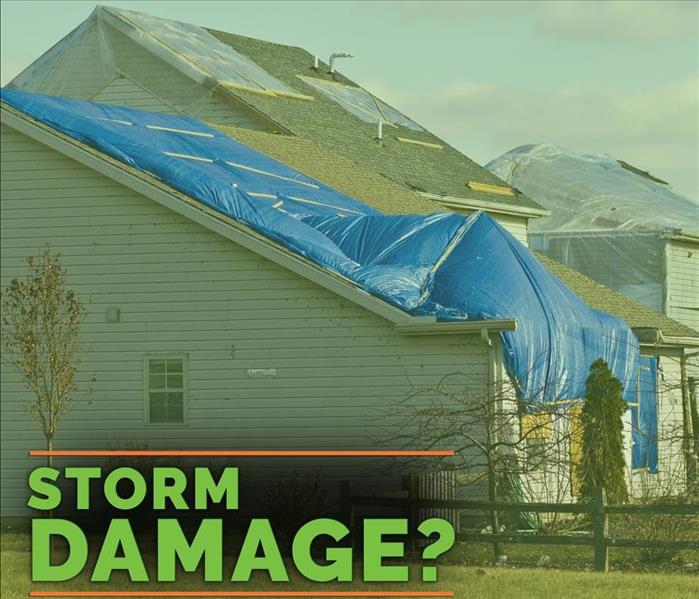 Roof damage in an Orlando, FL home
Roof damage in an Orlando, FL home
Roof Repair
When storms in Orlando, FL, damage your home’s roof, the idea of a roof repair can seem overwhelming. However, understanding what repairing a roof entails may make you feel more at ease about the process.
1. Assessment
Storms can affect various parts of a roof, and in order to know how to proceed in the repair process, it’s often necessary to assess the damaged roof. Hail and wind damage can cause shingles to crack or even blow away entirely, and the extent of the damage will determine what will happen next. In order to receive a thorough and accurate assessment, it can sometimes be helpful to employ storm damage restoration professionals.
2. Mitigation
Part of the roof repair process generally includes mitigating the damage. After an assessment has identified roof damage, tarps and board-up methods are often used to prevent the roof from further deteriorating. In addition to preventing the exterior of the home from sustaining more damage, it can also be useful to take measurements to protect the interior of the home. Roofs that have been affected by storms may cause water to become trapped in the home’s ceilings. Removing water from the ceiling in a timely manner can help to minimize the damage to the interior of the home.
3. Restoration
After an assessment and mitigation, the roof is restored. Any debris that is on or around the roof is first removed. Then, individual shingles that have been cracked or that have blown away due to strong winds can be replaced. If widespread damage has occurred to your roof, however, it may be necessary to replace the roof entirely to ensure the home is properly protected.
Knowing what is involved with a roof repair can help make the repair and restoration process less stressful. The repair process often involves the assessment of the roof, mitigating the damage and restoration.
Remediating Flood Damage
10/25/2018 (Permalink)
 When your home is flooded, SERVPRO is the company to quickly call for drying out services. We will dry out your carpet and assess the pad underneath.
When your home is flooded, SERVPRO is the company to quickly call for drying out services. We will dry out your carpet and assess the pad underneath.
SERVPRO Technicians Systematically Dry Out Your Carpet to Try and Save the Pad Underneath
Storms around the Orlando area are usually calm enough for the drains and area creeks and rivers to handle. When they are severe enough to generate floods, every home in their path is affected to one point or another.
Unless the water generated is massive, most Lee's Summit flood damage restoration efforts center around drying the carpets. SERVPRO technicians attempt to use in-place drying for carpets if possible and remove most of this water by extraction.
Our teams start the process with specialized equipment that pushes into the carpet and squeezes the water out through an extraction wand. They first remove water from the center of the room and then move the furniture either to the center or remove it completely from the affected area before starting. Once they finish the center, the teams begin extracting water from around the perimeter of the room in sections of 10 square feet or smaller.
After our teams complete one pass over the affected room, an inspector or team leader carefully lifts up one corner of the carpet and examines the pad. If he can squeeze water out of it, the restoration team repeats the extraction process until no more water squeezes out of the pad. They do this as quickly as possible since carpet pads rapidly deteriorate if underwater too long.
If the inspector sees that deterioration has started, he recommends removing and replacing the pad immediately. In-place extraction takes longer to remove water, but it can cost less in labor since time is not wasted by detaching the carpet and removing it from the affected rooms.
Once the team completes extraction, SERVPRO uses a combination of dehumidifiers and air movers to remove moisture in the surrounding air and to dry both the underside and the surface of the carpet. These devices working together can return a room to its pre-flood condition in just a day or two.
Drying carpets are one of the processes SERVPRO of SW Orlando uses to return homes to a dry, safe condition. If you are dealing with any recent or older flooding, contact us today at (407) 704-0327 to schedule an inspection. We are here to help.
Pet Storm Preparedness
10/16/2018 (Permalink)
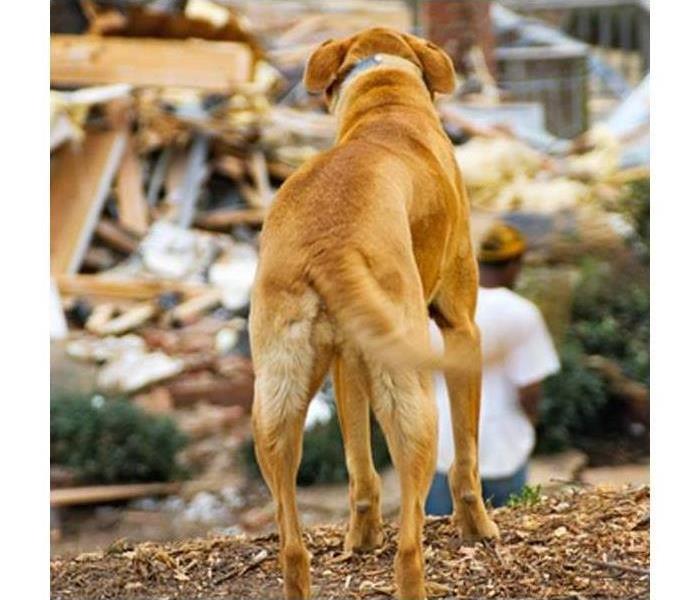 Don't let your pet be unprepared.
Don't let your pet be unprepared.
Pet Storm tips from SERVPRO of SW Orlando -
Did you know that almost all dog and cat owners don't have disaster plans for their pets? SERVPRO of SW Orlando urges you to make sure this isn’t you.
You made a disaster kit for yourself and family, so make one for your pet. This includes medical records and medication, food and water with can openers, leashes, and carriers.
Tips:
- Keep pets inside during a storm. Animals can become confused and run away from home during a disaster.
- Arrange a safe haven for you and your pets during evacuation. Do not leave pets behind.
- Store an emergency kit—with items such as pet food, bottled water, medical records, a blanket, a flashlight and leashes—as close to an exit as possible.
- Make sure all pets wear collars and tags.
- Have your pet microchipped in case of a lost collar.
- Place a rescue alert sticker to your front home to let rescuers know that there are pets inside.
- Choose a caregiver to take care of your pet in the event you are unable to.
SERVPRO of SW Orlando 407-704-0327
Dangers of Flash Flooding in Orlando, FL
10/11/2018 (Permalink)
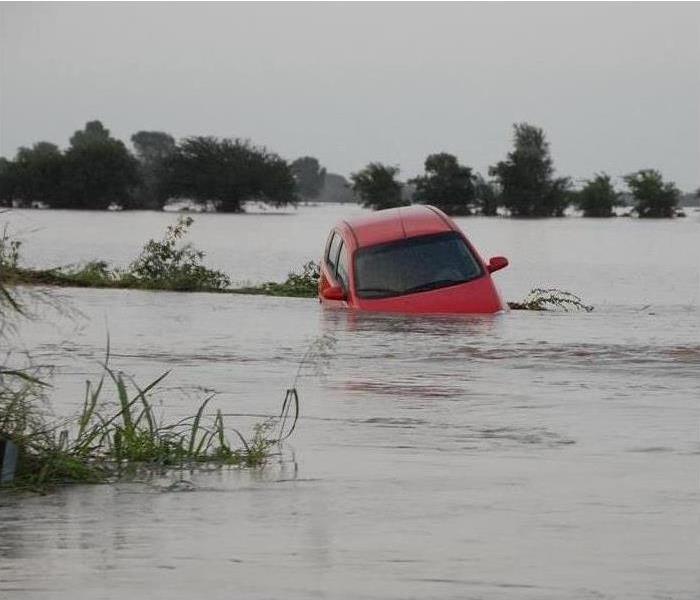 If flooding does occur in your area, listen to and adhere to weather alerts and warnings and know your risk!
If flooding does occur in your area, listen to and adhere to weather alerts and warnings and know your risk!
Flooding is the number #1 weather related cause of death, with majority of those deaths caused by flash flooding. Flash flooding is when there is a large amount of rain that comes down within minutes or hours. Other causes can be heavy rain associated with a severe thunderstorm, hurricane, tropical storm, or melt water from ice or snow flowing over ice sheets or snowfields.
If flooding does occur in your area, please remember
- Listen to NOAA Weather Radio for current and forecasted conditions in your area.
- If flooding begins in your area, go to higher ground immediately.
- When driving, always be aware that the road bed under flood waters may be severely damaged. NEVER drive through flooded roadways. Remember that it takes only two feet of water to carry away a vehicle, including pickups and SUVs.
- When walking, do not attempt to cross flowing streams. Remember that it takes only six inches of rushing water to knock an adult off his feet.
- If your vehicle stalls, get out immediately and go to higher ground.
- Be extra cautious at night, when it is harder to see possible flood dangers.
- These four words could save your life: TURN AROUND, DON’T DROWN.
When it comes to water damage from flooding, safety is the number one priority. When you can insure the safety of your family and conditions have improved, that is when to call in the professionals and assess damage. Our SERVPRO team is ready for whatever happens.
Storm Damage Can Happen Anywhere!
9/18/2018 (Permalink)
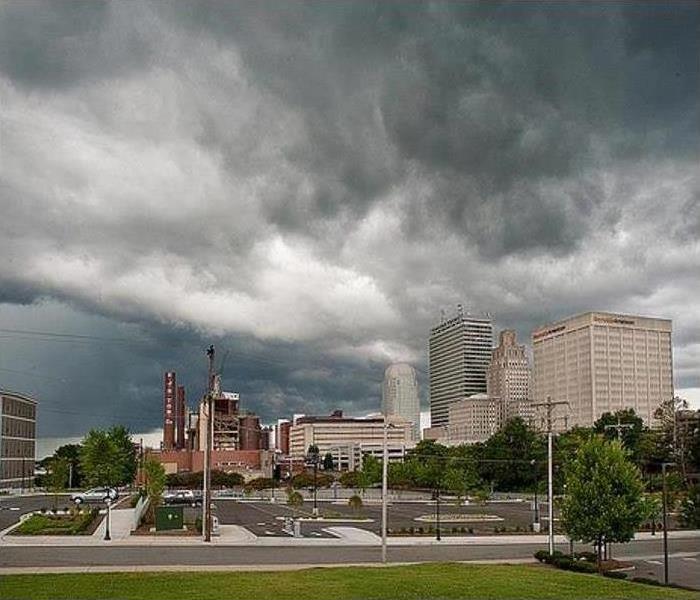 Call Southwest Orlando SERVPRO today to begin you ERP. 407-704-0327
Call Southwest Orlando SERVPRO today to begin you ERP. 407-704-0327
According to the National Weather Service (NOAA), “Approximately seventy-five percent of all Presidential disaster declarations are associated with flooding.” NOAA lists the most common flood hazards in the United States as:
- Flash Flooding
- River Flooding
- Storm Surge and Coastal Inundation from Tropical and Non-Tropical Systems
- Burn Scars/Debris Flows (Caused by Wildfires)
- Ice/Debris Jams
- Snowmelt
- Dry Wash (Caused by heavy rainfall in dry areas)
- Dam Breaks/Levee Failure
Just because you haven’t experienced a flood doesn’t mean you won’t in the future. In fact, 20% of all claims paid by the National Flood Insurance Program (NFIP) were for policies in low-risk communities. On average, floods cost $3.5 billion in annual losses in the U.S., and commercial flood claims average more than $75,000 (NFIP).
When catastrophic water damage happens to you, SERVPRO® Southwest Orlando Professionals can help. They can help you prepare ahead of time with an Emergency Ready Profile® (ERP), or respond to any size disaster to begin cleanup and restoration to get you back in business as soon as possible.
Your local SERVPRO® Southwest Orlando Professionals are ready to help make it “Like it never even happened."
Storm Damage - How to Take Care of Your Property
8/30/2018 (Permalink)
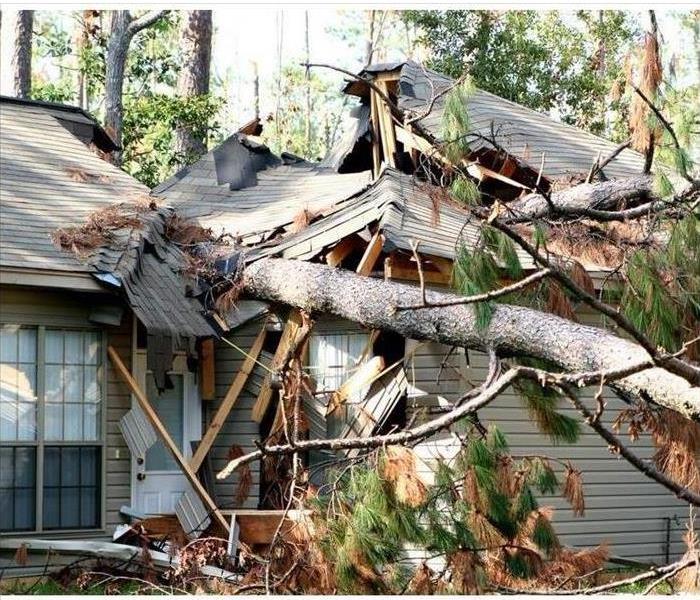 Don't let storm damage ruin your day, call SERVPRO to make it "Like it never even happened"
Don't let storm damage ruin your day, call SERVPRO to make it "Like it never even happened"
Dealing with repairs and insurance companies after severe weather hits your property can be difficult. Homeowners can use the following tips to help tackle the storm damage caused by hard rains, flooding, or storm-related issues.
SAFETY FIRST
If you and your family were away from home when the storm hit, do not return until it has been confirmed safe. Contact a storm damage expert like SERVPRO of Southwest Orlando; we’ll help you determine if your home is safe to return to.
INSURANCE
You will need to contact your homeowners’ insurance adjuster as soon as possible. If your neighborhood has sustained widespread damage, find out if any special teams of insurance agents, relief workers, or contractors are coming to the area. Check your policy to find out what actions you need to take or talk to your agent to make sure you are following the proper procedures. Not following these actions correctly could result in a reduced claim. Inspect your property and make a list of all damages; take photographs of all noted damage if at all possible.
RECORDING AND DOCUMENTING
Document your neighbor’s damages, as well; this can prevent the insurance provider from downgrading your claim by saying the damage is from your neglect of maintenance or other unrelated issues by giving them a way to compare. Keep a record of all the communication you have with your insurance provider, and don’t do any unnecessary repair work yourself. Hire a trusted storm damage restoration service provider such as SERVPRO of Southwest Orlando to handle any repairs.
BE SCAM FREE
Always check the adjuster’s identification. If you are evacuated, ask for money from your claim upfront. If they agree, you will be given a check for an amount that will be deducted from your final settlement. Some providers will automatically offer a partial payment early on during the process. Review it carefully and decline it if you feel uncomfortable with any part of it. Never be afraid to ask questions and to expect an answer that makes sense or seems fair.
Dealing with a storm's aftermath is stressful, but reacting properly will be an immense help and can prevent problems down the road.
The SERVPRO of Southwest Orlando team is ready to help 24/7. Call us for your fire or water damage issues at (407)704-0327






 24/7 Emergency Service
24/7 Emergency Service












